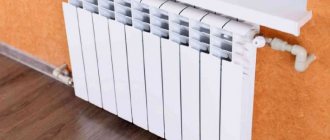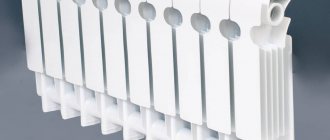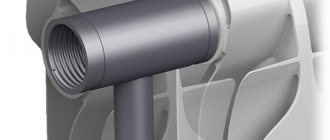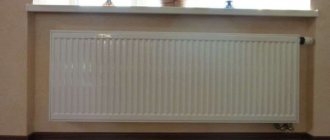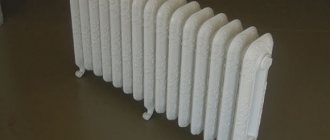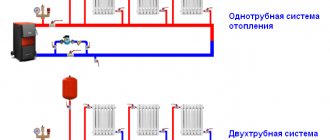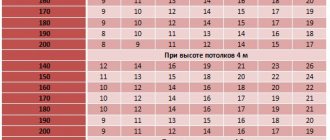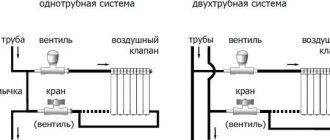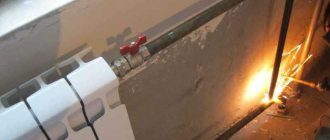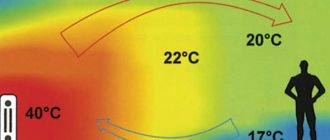Here you will learn about calculating sections of aluminum radiators per square meter: how many batteries are needed for a room and a private house, an example of calculating the maximum number of heaters per required area.
It is not enough to know that aluminum batteries have a high level of heat transfer.
Before installing them, it is imperative to calculate exactly how many of them should be in each individual room.
Only knowing how many aluminum radiators are needed per 1 m2 can you confidently buy the required number of sections.
Calculation of aluminum radiator sections per square meter
As a rule, manufacturers pre-calculate the power standards for aluminum batteries, which depend on parameters such as ceiling height and room area. It is believed that heating 1 m2 of a room with a ceiling up to 3 m in height will require a thermal power of 100 W.
These figures are approximate, since the calculation of aluminum heating radiators by area in this case does not provide for possible heat loss in the room or higher or lower ceilings. These are generally accepted building standards that manufacturers indicate in the technical data sheets of their products.
Except them:
- The parameter of the thermal power of one radiator fin is of considerable importance. For an aluminum heater it is 180-190 W.
- The temperature of the media must also be taken into account. It can be found out from the heating management office if the heating is centralized, or it can be measured independently in an autonomous system. For aluminum batteries the figure is 100-130 degrees. Dividing the temperature by the thermal power of the radiator, it turns out that 0.55 sections are required to heat 1 m2.
- In the event that the ceiling height has “outgrown” classical standards, then it is necessary to apply a special coefficient:
- if the ceiling is 3 m, then the parameters are multiplied by 1.05;
- at a height of 3.5 m it is 1.1;
- with an indicator of 4 m - this is 1.15;
- wall height 4.5 m – coefficient is 1.2.
- You can use the table that manufacturers provide for their products.
How many sections of aluminum radiator are needed?
The number of sections of an aluminum radiator is calculated according to a form suitable for heaters of any type:
Q = S x100 x k/P
In this case:
- S – area of the room where the battery installation is required;
- k – adjustment factor of 100 W/m2 depending on the ceiling height;
- P – power of one radiator element.
When calculating the number of sections of aluminum heating radiators, it turns out that in a room with an area of 20 m2 with a ceiling height of 2.7 m, an aluminum radiator with a power of one section of 0.138 kW will require 14 sections.
Q = 20 x 100 / 0.138 = 14.49
In this example, the coefficient is not applied, since the ceiling height is less than 3 m. But even such sections of aluminum heating radiators will not be correct, since possible heat loss in the room is not taken into account. It should be borne in mind that depending on how many windows there are in the room, whether it is corner and whether it has a balcony: all this indicates the number of sources of heat loss.
When calculating aluminum radiators by room area, the formula should take into account the percentage of heat loss depending on where they will be installed:
- if they are fixed under the window sill, then the losses will be up to 4%;
- installation in a niche instantly increases this figure to 7%;
- if an aluminum radiator is covered with a screen on one side for beauty, then the losses will amount to 7-8%;
- completely covered with a screen, it will lose up to 25%, which makes it, in principle, unprofitable.
These are not all the indicators that should be taken into account when installing aluminum batteries.
Calculation of the number of sections taking into account climatic conditions
The manufacturer indicates the thermal power value of one radiator section under optimal conditions. Climatic conditions, system pressure, boiler power and other parameters can significantly reduce its efficiency.
Therefore, when calculating, these parameters should be taken into account:
- If the room is corner, then the value calculated using any of the formulas should be multiplied by 1.3.
- For every second and subsequent windows you need to add 100 W, and for a door - 200 W.
- Each region has its own additional coefficient.
- When calculating the number of sections for installation in a private house, the resulting value is multiplied by 1.5. This is due to the presence of an unheated attic and the external walls of the building.
Calculation example
If you calculate how many sections of an aluminum radiator are needed for a room with an area of 20 m2 at a rate of 100 W/m2, then adjustment coefficients for heat loss should also be made:
- each window adds 0.2 kW to the indicator;
- the door “costs” 0.1 kW.
If it is assumed that the radiator will be placed under the window sill, then the correction factor will be 1.04, and the formula itself will look like this:
Q = (20 x 100 + 0.2 + 0.1) x 1.3 x 1.04 / 72 = 37.56
Where:
- the first indicator is the area of the room;
- the second is the standard number of W per m2;
- the third and fourth indicate that the room has one window and one door;
- the next indicator is the heat transfer level of the aluminum radiator in kW;
- the sixth is a correction factor regarding the location of the battery.
Everything should be divided by the heat output of one heater fin. It can be determined from the table from the manufacturer, which shows the heating coefficients of the carrier in relation to the power of the device. The average for one edge is 180 W, and the adjustment is 0.4. Thus, multiplying these numbers, it turns out that one section produces 72 W when heating water to +60 degrees.
Since rounding is done upward, the maximum number of sections in an aluminum radiator specifically for this room will be 38 fins. To improve the performance of the structure, it should be divided into 2 parts of 19 ribs each.
Technical features of a sectional radiator
Design
The photo shows a separate section.
Sectional batteries have almost the same design. They are a system of two horizontal collectors connected by vertical channels. The vertical tubes have plate ribs on the outside that form channels for the movement of convection currents and increase the area of thermal interaction.
The distance between the plates is selected so that the convection flows are not laminar, but turbulent. This increases the intensity of air interaction with the surface of the housing.
The plates increase the heat transfer area of the device.
The structure is divided into equal parts. One such part includes a vertical channel and two collector elements, one at the top and the other at the bottom. The collector element forms a T-shaped connection with the vertical channel, the two open holes of which are adapted to be combined with other similar collector holes.
The parts are connected using a special nipple with a seal.
If the part is installed on the edge, then the hole is closed with a plug or used to connect the supply, return or air valve.
The photo shows how to remove a section from an aluminum radiator.
Let's consider the operation of a battery with a similar design:
- The parts are assembled into a solid battery, a coolant supply pipe is connected to one of the holes, a waste liquid discharge pipe is connected to the other, a Mayevsky valve for draining excess air is connected to the third, the fourth hole is closed with a plug;
- The coolant enters the collector and gradually fills the entire device. Aluminum has high thermal conductivity, approximately four times higher than steel. Therefore, the case begins to warm up quickly;
- The heated surface of the convector begins to radiate thermal energy. Heat radiation in the infrared range accounts for approximately 50–60% of the total heat transfer of the device;
- The air in contact with the surface of the housing begins to heat up due to direct heat transfer. Under the influence of gravity, heated masses begin to move upward along the channels formed by the ribs of the convector, and new portions of cold air are drawn into the battery from below;
- The device begins to work as a gravity pump. The air flows passing through the channels take on a vortex nature, which increases the heat transfer of the plates due to mixing.
The width of the aluminum radiator section affects the heat emitted.
Important! The main advantage of the sectional design is the ability to change the power and size of the device with your own hands.
Characteristics and Features
The size of the aluminum radiator section depends on the center distance.
The main technical characteristic of any heater is its thermal power. This is the amount of heat that the device transfers to the environment per unit time. Measured in kcal/hour or watts.
Power depends on many factors, among which the main ones are:
- instrument surface area;
- coolant temperature;
- channel capacity (how many liters in one section of an aluminum radiator);
- thermal pressure;
- thermal conductivity of the material;
- body design;
- connection method for supply and return.
Before adding sections to aluminum radiators, a nipple is screwed into the hole.
Since the maximum number of sections in an aluminum radiator has not been established, and different devices have different sizes, it is more convenient to consider the parameters of one individual part, and then determine the characteristics of the battery by adding the values of each part.
An aluminum radiator with 10 sections will have ten times the rated power.
Let's look at the technical characteristics in more detail:
| Specifications | Parameter values |
| Height (center distance) | 250, 300, 350, 400, 450, 500 mm. The most common sizes are 350 – 500 mm. Vertical models can reach 1 – 2 meters in height |
| Depth | For standard models 80 – 140 mm |
| Width | For most products 80mm |
| Capacity | 0.25 – 0.5 liters |
| Wall thickness | 2 – 3 mm |
| Heat transfer area | 0.4 – 0.6 m² |
| Power | 80 – 220 W, more often 140 – 160 W |
| Maximum coolant temperature | 130˚С |
| Operating pressure | 6 – 24 atm. |
The price of the product depends on its power and manufacturer.
Important! To connect to centralized coolant supply systems, you should select models with a maximum (pressure test) pressure of at least 45 atm. and a working pressure of at least 16 atm.
Calculation by volume
If you make such calculations, you will need to refer to the standards established in SNiP. They take into account not only the performance of the radiator, but also what material the building is built from.
For example, for a brick house the norm for 1 m2 will be 34 W, and for panel buildings - 41 W. To calculate the number of battery sections based on the volume of the room, you should: multiply the volume of the room by the heat consumption standards and divide by the heat output of 1 section.
For example:
- To calculate the volume of a room with an area of 16 m2, you need to multiply this figure by the height of the ceilings, for example, 3 m (16x3 = 43 m3).
- Heat standard for a brick building = 34 W, to find out how much is required for a given room, 48 m3 x 34 W (for a 41 W panel house) = 1632 W.
- We determine how many sections are required with a radiator power, for example, 140 W. For this, 1632 W/ 140 W = 11.66.
Rounding this figure, we get the result that a room with a volume of 48 m3 requires an aluminum radiator of 12 sections.
Thermal power of 1 section
As a rule, manufacturers indicate average heat transfer rates in the technical characteristics of heaters. So for heaters made of aluminum it is 1.9-2.0 m2. To calculate how many sections are required, you need to divide the area of the room by this coefficient.
For example, for the same room with an area of 16 m2, 8 sections will be required, since 16/2 = 8.
These calculations are approximate and cannot be used without taking into account heat loss and the actual conditions for placing the battery, since you can get a cold room after installing the structure.
To get the most accurate indicators, you will have to calculate the amount of heat that is needed to heat a specific living space. To do this, you will have to take into account many correction factors. This approach is especially important when calculating aluminum heating radiators for a private home is required.
The formula needed for this is as follows:
KT = 100W/m2 x S x K1 x K2 x K3 x K4 x K5 x K6 x K7
- KT is the amount of heat that a given room requires.
- S – area.
- K1 – designation of the coefficient for a glazed window. For standard double glazing it is 1.27, for double glazing it is 1.0, and for triple glazing it is 0.85.
- K2 is the coefficient of the wall insulation level. For a non-insulated panel it = 1.27, for a brick wall with one layer of masonry = 1.0, and for two bricks = 0.85.
- K3 - this is the ratio of the area occupied by the window and the floor.When in between:
- 50% - coefficient is 1.2;
- 40% — 1.1;
- 30% — 1.0;
- 20% — 0.9;
- 10% — 0.8.
- K4 is a coefficient that takes into account the air temperature according to SNiP on the coldest days of the year:
- +35 = 1.5;
- +25 = 1.2;
- +20 = 1.1;
- +15 = 0.9;
- +10 = 0.7.
- K5 indicates adjustment if there are external walls.For example:
- when she is alone, the indicator is 1.1;
- two external walls – 1.2;
- 3 walls – 1.3;
- all four walls – 1.4.
- K6 takes into account the presence of a room above the room for which calculations are made.In the presence of:
- unheated attic - coefficient 1.0;
- heated attic – 0.9;
- living room – 0.8.
- K7 is a coefficient that indicates the height of the ceiling in the room:
- 2.5 m = 1.0;
- 3.0 m = 1.05;
- 3.5 m = 1.1;
- 4.0 m = 1.15;
- 4.5 m = 1.2.
If you apply this formula, you can foresee and take into account almost all the nuances that may affect the heating of the living space. Having made a calculation using it, you can be sure that the result obtained indicates the optimal number of aluminum radiator sections for a particular room.
Whatever principle of calculation is undertaken, it is important to do it as a whole, since correctly selected batteries allow you not only to enjoy warmth, but also significantly save on energy costs. The latter is especially important in the context of constantly rising tariffs.
How to correctly compare bimetallic radiators with each other?
Anyone who carefully approaches the choice of heating batteries for their home or apartment strives to purchase products with optimal performance and technical characteristics. To correctly select the most suitable radiator, the models being compared must be of the same size. In the reference data, the parameters are given for one section, so you need to compare not the devices as a whole, but their structural parts. The main parameter by which the division into standard sizes occurs is the interaxle distance.
Radiators with different center distances.
The center distance is the size between the axis of the upper and lower collector. Like all-aluminum models, bimetallic heating radiators are mainly produced with a center distance from 200 to 800 mm. Models with a large center distance, and as a consequence, with an increased section height (but a smaller width of the entire radiator), are rare. They are used if the interior features of the room do not allow placing a horizontally located device.
The device of a bimetallic radiator.
Geometric parameters
The main geometric characteristics of a bimetallic radiator are its height, as well as the width and depth of the section. The height, as a rule, is 60 - 80 mm higher than its center distance.
Most manufacturers produce models with a section width of 80 mm. Knowing the number of sections, you can easily determine the total width of the device.
The depth of the section is 80 – 100 mm. The radiator can be either constant depth or varying in height, like the stylish and elegant DreamLiner series device from Royal Thermo.
Installation of a heating radiator on a wooden wall.
Thermal power
This parameter allows you to determine how many radiator sections of a particular model are needed to heat a room of a certain area. Thermal power is measured in Watts and is at an interaxial distance:
- 500 mm – from 170 to 200 W;
- 350 mm – from 120 to 140 W;
- 300 mm – from 100 to 145 W;
- 200 mm – about 100 W.
In their information and technical materials (instructions, manuals, catalogs), manufacturers indicate tables showing the number of sections optimal for heating rooms of various sizes.
The steel core is the basis of the structure.
Volume (capacity) of one section
In bimetallic radiators, coolant circulates through steel cores. The core is an H-shaped welded structure consisting of an upper and lower collector connected to each other by a vertical tube (heat pipe). Each manifold has two side holes with internal threads, thanks to which the sections can be connected using steel nipples. This design completely eliminates contact of the coolant with aluminum.
Unlike aluminum radiators, where the heat pipe has an oval cross-section, the steel cores of bimetallic models use exclusively round tubes, which provides for a smaller capacity of each section. Thus, the bimetallic Rifar Base 500 has a section capacity of 0.20 liters, while the aluminum Rifar Alum 500 model of the same size has a volume of 0.27 liters.
Section of the device in section.
Section weight
Bimetallic radiators have more mass than similar models of aluminum radiators. This is explained by the use of steel cores in their design, the density of which (and therefore the mass) exceeds that of aluminum. For example, the bimetallic radiator Varmega Bimega 500/80 weighs 1.75 kg, and the aluminum radiator Almega 500/80 from the same manufacturer weighs 1.2 kg.
Pressure
The operating pressure of bimetallic radiators is 16 – 40 atm (1.6 – 4.0 MPa). According to regulatory documents, devices must be tested by pressure testing the heating system with a pressure 1.5 times higher than the operating value. The documentation also indicates the value of the maximum pressure, upon reaching which it can begin to collapse.
Connection of sections.

